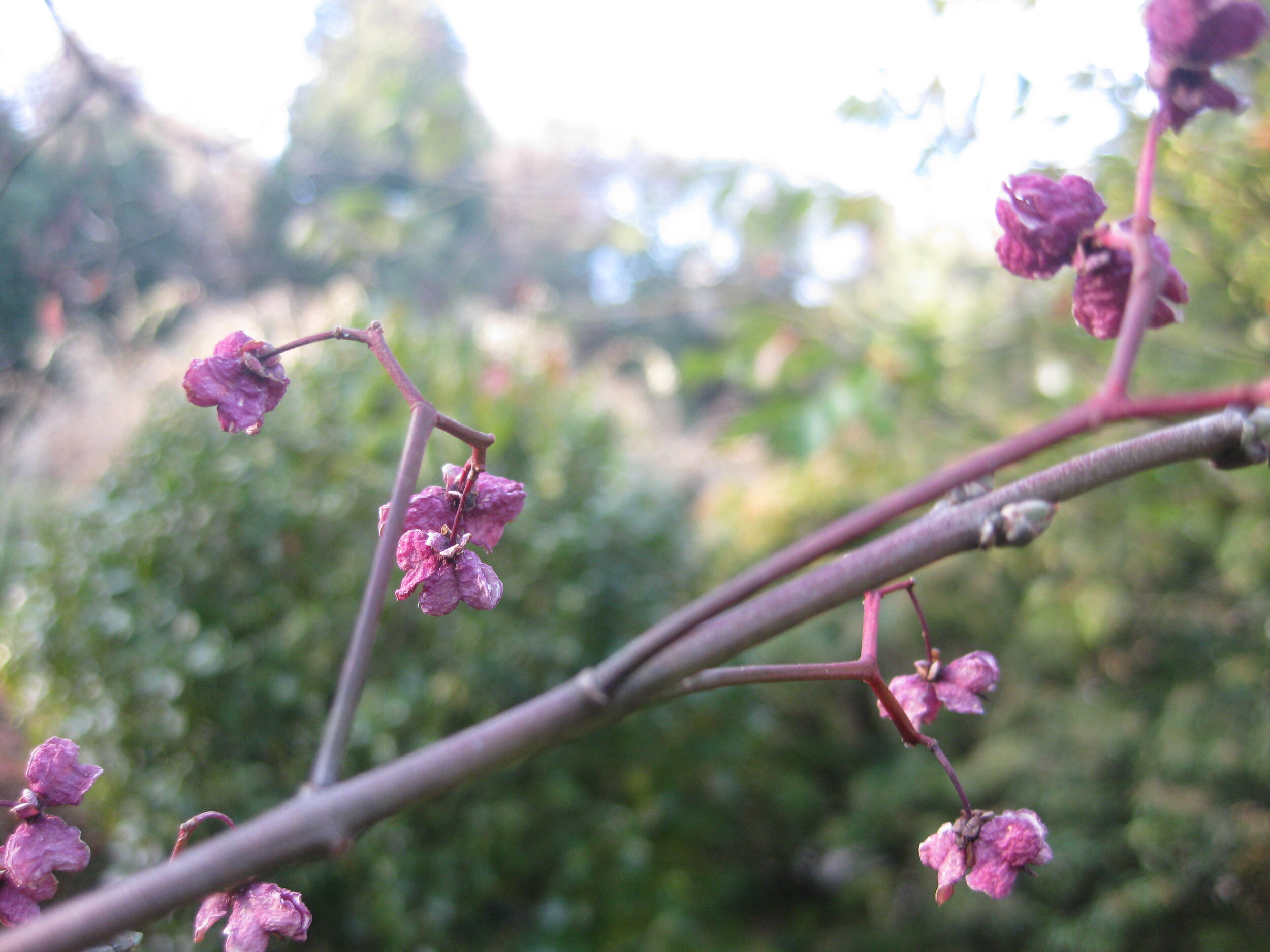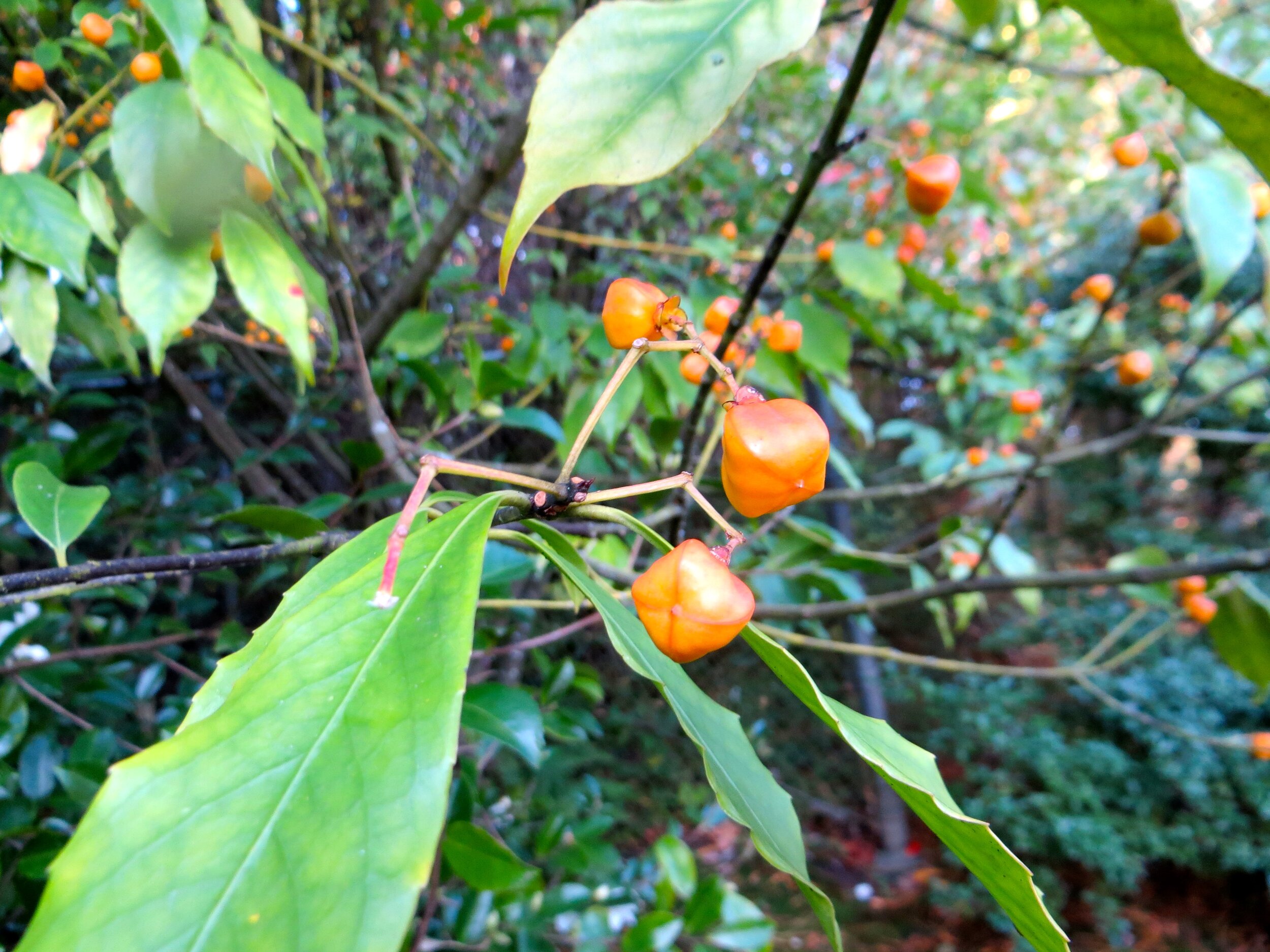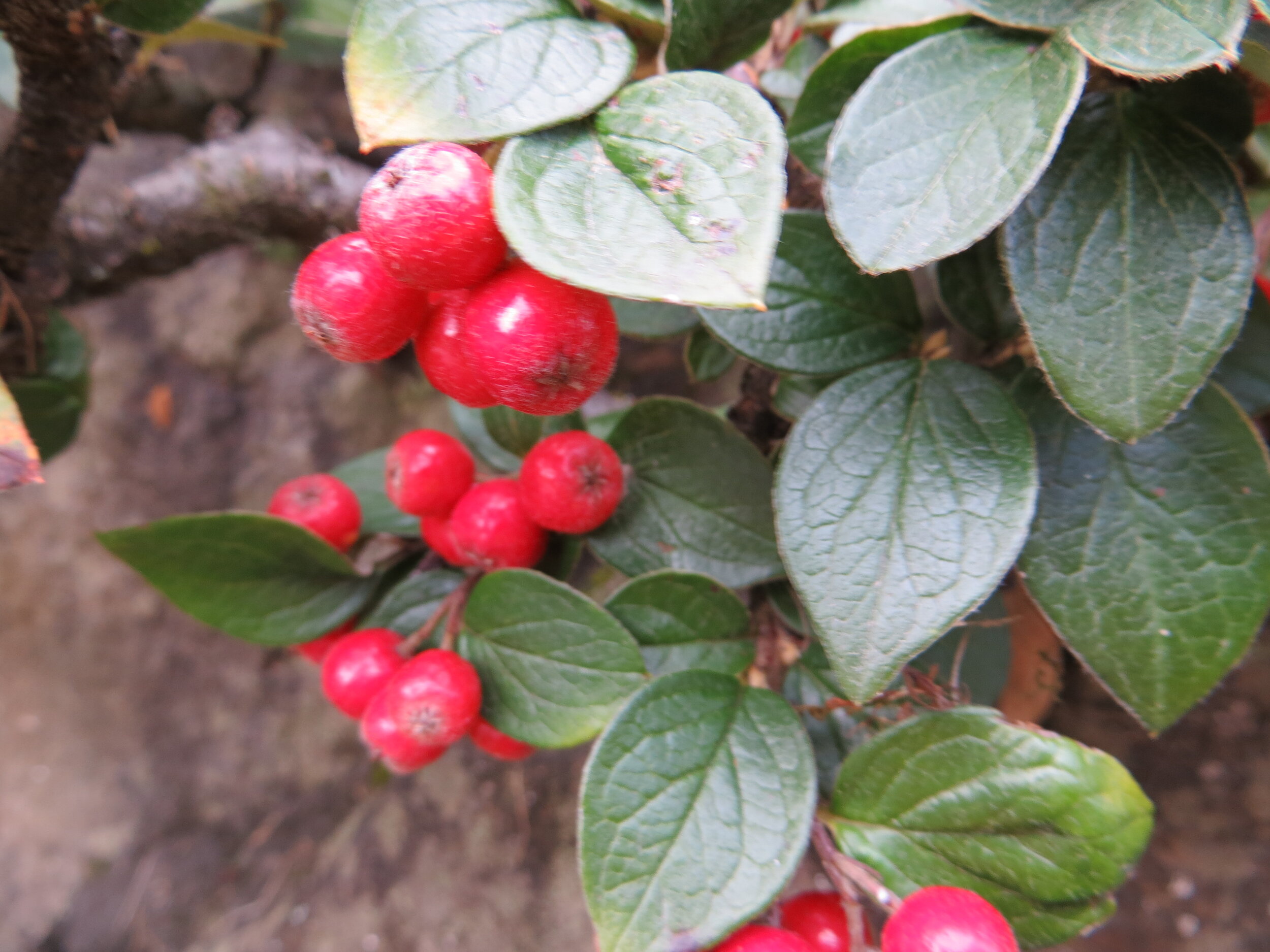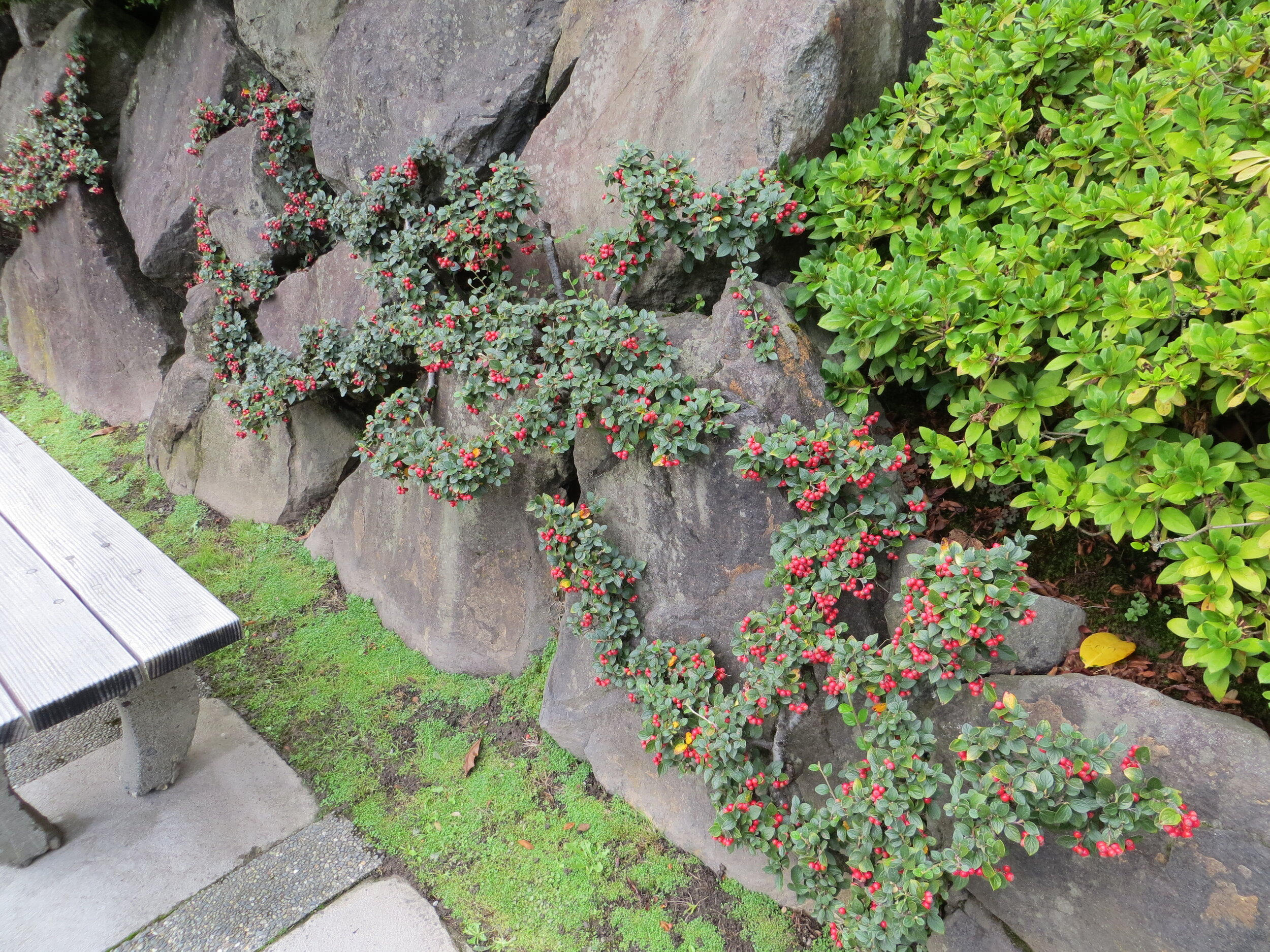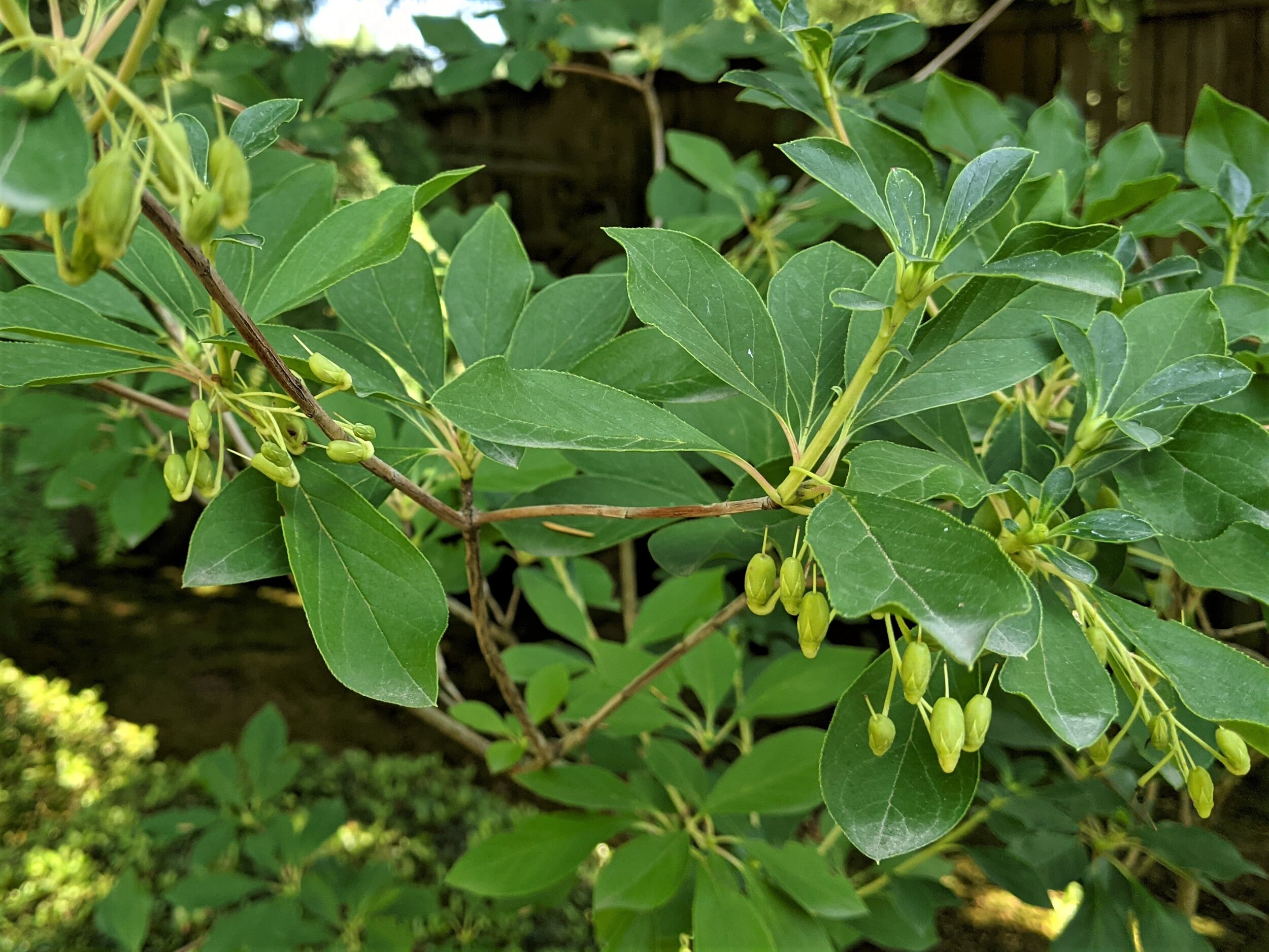The Fruits of Autumn in the Seattle Japanese Garden
By Corinne Kennedy
The fruits of Euonymus hamiltonianus ssp. sieboldianus in Area L, north of the Seattle Japanese Garden’s original East Gate. (photo: Aleks Monk)
With their brilliant fall colors, maples are the stars of autumn, not only in Japan but also in our own Seattle Japanese Garden. Yet the season’s beauty is not limited to autumn foliage. All too often overlooked are trees and shrubs with interesting fruit. Our Garden includes one tree species with large, showy fruit, but I’m equally charmed by the smaller fruits of its lesser-known plants. Here are some of my favorite woody plants with attractive, interesting, unusual and charming fruits:
Diospyros kaki (persimmon)
The beautiful autumn fruit of Diospyros kaki in the Seattle Japanese Garden. (photo: Mary Ann Cahill)
This old village –
not a single house
without persimmon trees
—Basho
Persimmon, Diospyros kaki, is a deciduous tree that was taken many centuries ago from its native China to Japan and Korea. In all three countries, its fruit has been an important food. Common names include Chinese persimmon, Japanese persimmon, oriental persimmon, and kaki. As suggested by the above haiku, trees were widely planted in Japan and central to the lives of its people. We’re fortunate to have two trees in the Seattle Japanese Garden, the larger one located west of the pond in the garden’s orchard area.
Diospyros kaki is also a cultural icon in Japan, represented in poetry, paintings, prints and ceramics, and strongly associated with the autumn season. “Season words” (kigo) are central to all haiku poems, and even foods have important seasonal connotations. A familiar and beloved autumn kigo, persimmon is also the only tree in our Garden with large and showy fruit. In botanical terms, it’s classified as a berry.
Spring’s pale green leaves mature to a deeper green in summer, then transform in fall into a blend of oranges and yellows, echoing the vivid yellow-orange fruits. Like enduring holiday ornaments, they are displayed into late fall and early winter.
Euonymus hamiltonianus ssp. sieboldianus, Euonymus hamiltonianus var. maackii and Euonymus myrianthus (large-growing species of Euonymus)
Fruits of Euonymus hamiltonianus var. maackii and Euonymus myrianthus in the Seattle Japanese Garden. (photos: Aleks Monk)
Our Garden also contains several large shrubs with smaller fruits that I find especially charming—three rare Euonymus species native to China, Korea, and Japan. Commonly known as spindle trees, they are rarely planted in the U.S. outside of botanical gardens or those of plant aficionados.
Our Garden’s three species have small, insignificant flowers that develop into interesting, unusual fruits. Colorful, dehiscent (dry) outer capsules are divided into multiple chambers. They split open at maturity to reveal fleshy arils that enclose the innermost seeds. Juicy and brightly colored, arils are attractive to birds—but plant parts are at least mildly toxic to humans.
The two deciduous species, related to Euonymus hamiltonianus, are large shrubs with irregular habits that in time may exceed 30 feet tall. They exhibit a great deal of variability in the wild and under cultivation, with botanical experts expressing widely differing opinions about their classification and nomenclature. Many synonyms are listed for both, but only those currently preferred are listed below.
Euonymus hamiltonianus ssp. sieboldianus, also known as Euonymus. sieboldianus (or our Garden’s plant may in fact be the species itself, Euonymus hamiltonianus), is an open deciduous shrub native to Japan, S Korea, and E China. The relatively large, oval leaves are pointed at their tips, and develop attractive fall color. Fruits are rose-pink, four-chambered capsules containing bright orange arils. Our Garden has one plant in Area L, north of the original East Gate, between the east-side path and the fence.
Euonymus hamiltonianus var. maackii (also known as Euonymus maackii) is native to the Russian Far East, N and NE China, and Korea. A deciduous, very cold hardy shrub, it has smaller and narrowly lance-shaped leaves, more finely toothed and tapered at both ends, and often develops attractive fall color. The pink fruits have four chambers containing bright orange arils. Our Garden has one plant in Area L, south of the area’s specimen of E. hamiltonianus ssp. sieboldianus. In the photo above, the capsules have already split open to shed their seed.
Euonymus myrianthus is a bold evergreen shrub, with large, leathery, green leaves. Native to W China, it is slower growing and less cold hardy than the two deciduous species—to only about 0 degrees Fahrenheit. Fruits are orange-yellow capsules containing bright orange-scarlet arils. Our Garden has three plants, two in Area L and one in Area S. The latter—located northwest of the northwest corner of the pond, between the path and the fence—is less obscured by other plants.
Cotoneaster dielsianus (cotoneaster)
Cotoneaster dielsianus in fruit along the rock wall at the northern end of our Garden. (photos: Aleks Monk)
Our Garden contains a single rare species of cotoneaster—Cotoneaster dielsianus, a deciduous shrub. Native to C China, it has a graceful growth habit with long, slender, arching shoots. However, as revealed in the photo above, it takes well to pruning and shaping. Pinkish flowers give rise to small, scarlet-red round or somewhat pear-shaped fruits, brightly colored in September and October. They are usually referred to as berries, but like apples and pears, they’re classified botanically as pomes. Small, deeply cut, heart-shaped leaves develop attractive fall color.
Many specimens are located at the northern end of the garden—notably along and above the long rock wall of the fishing village (Areas N and O). They have been carefully pruned into an espalier shape (trained into a horizontally spreading, flat plane), which highlights the brilliance of the fruits.
Enkianthus (pagoda bush)
Enkianthus campanulatus, with its small, oblong, greenish-tan fruits. (left photo, in our Garden, by Corinne Kennedy; right photo, with fall foliage, by Koichi Oda/Wikimedia Commons)
Enkianthus, sometimes known as pagoda bush, is a little-known genus in the Heather Family, Ericaceae, which also includes rhododendrons, azaleas, blueberries, huckleberries and, of course, heathers. Although its flowers are not as showy as most other spring-blooming shrubs, it’s a lovely plant with an elegant habit and subtle charms that contribute to the quiet, refined beauty we experience in the Seattle Japanese Garden. The Garden contains many plants that represent two Enkianthus species native to Japan.
Most of the plants in our garden are Enkianthus campanulatus, commonly known as redvein enkianthus—and the most common species in Western countries. Native to open woodlands in Japan, it has been cultivated there for centuries, often planted in groups, as a hedge, or in pots. Historically, the alcove posts in teahouses were made from the rustic-appearing wood. Enkianthus perulatus, less common in the West, is the most popular enkianthus species in Japan.
Both species are valued for their delicate and profuse spring flowers and fall color. I’m also very attracted to their clusters of small oblong fruits set off by the richly colored autumn foliage. Botanically, they’re dry, five-valved greenish-tan capsules that point upwards at the end of their long stalks.
In Autumn
For me, autumn is a season to be treasured—in the Seattle Japanese Garden and in my own garden as well. Plants are undergoing their beautiful, yet poignant, transformations. It’s a time to be mindful—not simply of a garden’s beauty, but of all its moods. And to be reminded that Japanese-style gardens differ from gardens here, which tend to emphasize long-lasting flower displays above all else.
Japanese gardens, in contrast, celebrate the fleeting nature of beauty, the inevitability of change, and the passage from life to death. As leaves turn color and then drop, fruits not eaten by birds or other wildlife will drop or wither on the plant. Like all beauty, their loveliness is ephemeral, a moment in the cycle of life.
Corinne Kennedy is a Garden Guide, frequent contributor to the Seattle Japanese Garden blog, and retired garden designer.



